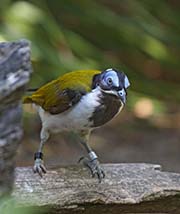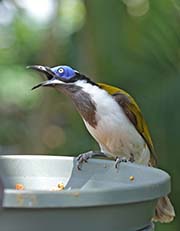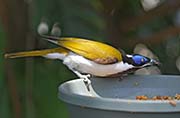Blue-faced Honeyeater - Entomyzon cyanotis
| Length | |
| Wingspan | |
| Weight | |
| Clutch Size | |
| Chicks at birth | |
| IUCN Conservation Status | |
Continents: |
Three subspecies of Blue-faced Honeyeaters are found in Australia and Papua New Guinea. Blue-faced Honeyeaters have white underparts and olive green upperparts. They have a black head and throat, white nape and blue skin around their yellow eyes. Their legs and feet are gray. Both sexes are similar in plumage. Juveniles differ from adults by the color of the bare skin around their eyes which is a yellowish-green.
Blue-faced Honeyeaters live together in pairs or small groups.
Diet: Blue-faced Honeyeater's eat a variety of invertebrates such as grasshoppers, flies, bees, ants, beetles, etc. They also consume nectar from flowers and eat berries, grapes, and pollen. They are also called Bananabirds because they love to eat banana fruit and flowers.
Courtship: In the wild they normally breed between August through November and will produce one or two broods a year.
Nesting: Blue-faced Honeyeaters will reuse other species abandoned nests. They may modify them and/or relined them with grass and spider webs. If they build from scratch, it is cup-shaped and usually built in the fork of a tree. These nests are made from rough bark and lined with finer bark and grasses.
The female will lay 2-3 eggs and does all the incubation. Both parents feed the hatched chicks.
Habitat and Range: The Blue-faced Honeyeater is found in northern and eastern Australia and in Papua New Guinea. They prefer open forests and woods, banana plantations, orchards, parks, and gardens near water.
Vocalization: They are considered noisy and gregarious birds. They start their song at dawn.
Plumage/Molt They do not have an alternate or breeding plumage.
Migration: They are non-migratory. They are sedentary in northern Australia and locally nomadic in the southern part of their range.
Tongue/feet: Blue-faced Honeyeaters evolution has produced a tongue and bill that is very suitable for getting the nectar out of flowers. The bill is long and conical. The tongue is long and frayed with bristles that soak up the nectar when the tongue is inserted into a flower. When the tongue is returned to the mouth, the bristles are pressed against projections on the roof of the mouth, squeezing out the nectar. This can happen 10 times per second.
Bibliography:
- http://en.wikipedia.org The Free Encyclopedia, Accessed July, 2012
- http://www.birdsinbackyard.net Birds in Backyards, Accessed July, 2012
- http://birdlife.org BirdLife International, Accessed July, 2012
- http://www.edinburghzoo.org.uk/animals/individuals/ Edinburgh Zoo, Accessed July, 2012
- http://australianmuseum.net.au Australian Museum, Accessed July, 2012
- http://torontozoo.com/ExploretheZoo Toronto Zoo, Canada, Accessed July, 2012










